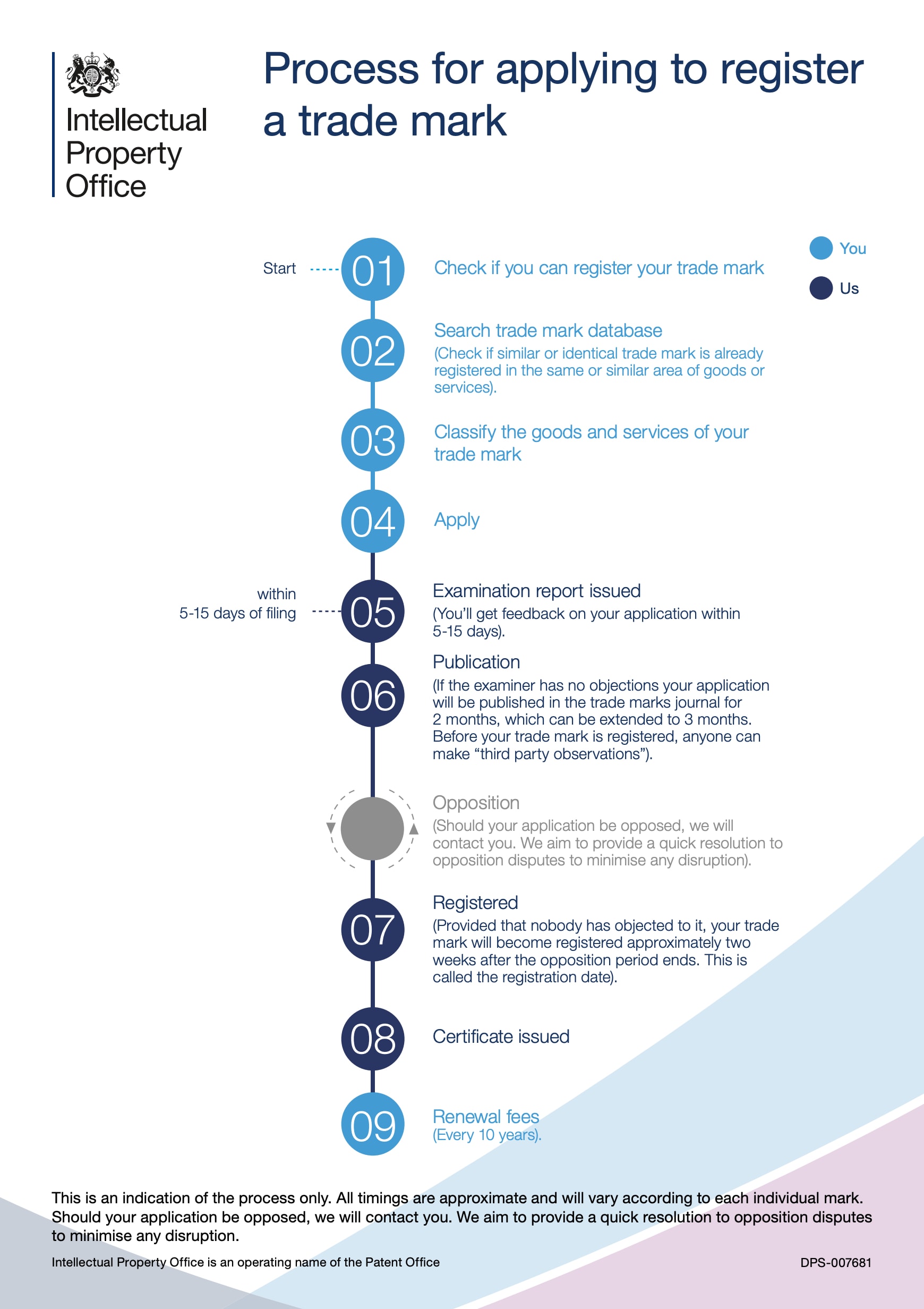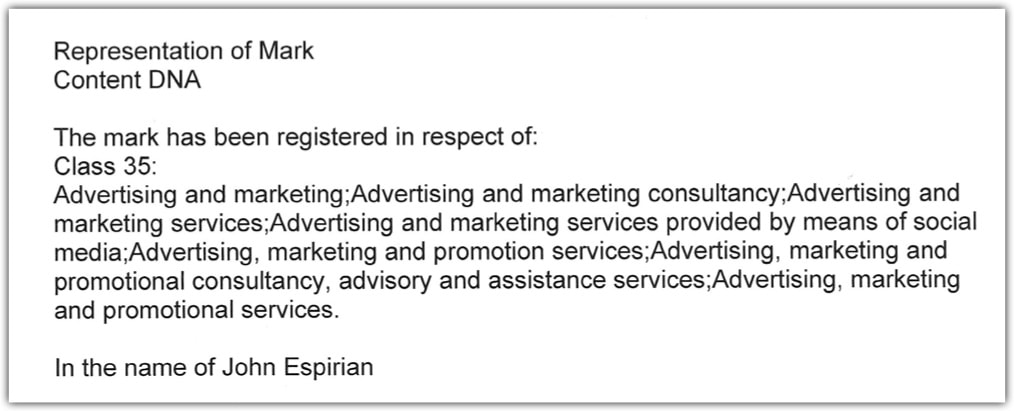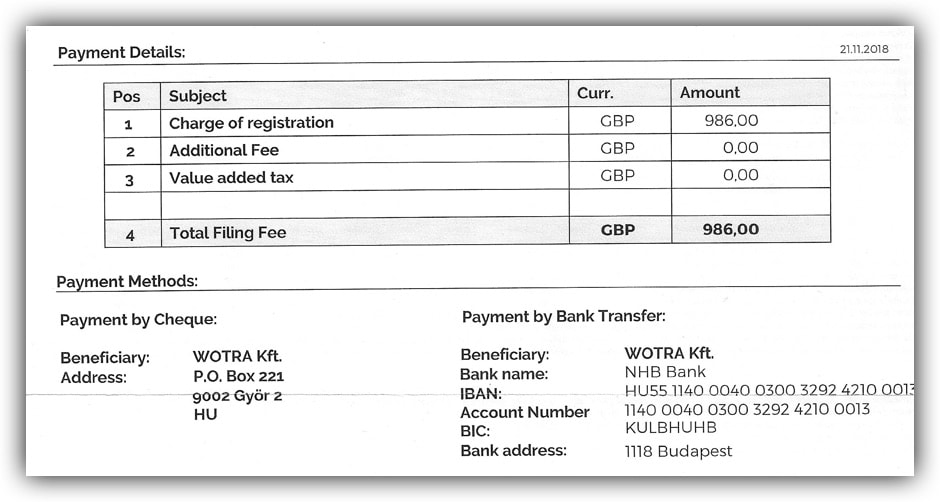Register a name or phrase for your UK business.
Have you ever wanted to trademark a name or phrase for your business?
You can do it online in the UK for as little as £170. And you probably won’t need a lawyer or any external help.
- Introduction
- How to check whether a trademark exists
- What are the trademark classes?
- How much does it cost to apply for a trademark?
- The 2-month opposition period
- Look out for unexpected communications
- How long do trademarks last?
- When to use the trademark and registered symbols
- Let’s wrap up
Here’s a quick audio summary to explain the trademark process:
And here’s the high-level view supplied by the Intellectual Property Office (IPO):

Source
Introduction.
When I came up with Content DNA – the name for the book I’m writing – I decided to trademark it.
This meant I could feel safe that no one else would reuse the name for some other marketing venture.
When I started my application, I didn’t know who can register a trademark or anything about the trademark process.
This post covers what I’ve learned.
Disclaimer.
I’m not an intellectual property expert, and I can’t guarantee that the process below won’t change. I also don’t know the process in other countries.
What follows is what was relevant to my trademark application in the UK.
More in-depth articles here to show how trademark law is changing:
How to check whether a trademark exists.
There’s no point wasting time on an idea that someone else has already trademarked.
You can search for a trademark by word, phrase or image on the website of the IPO.
When I did my search, I also checked Google, Twitter and LinkedIn.
You might also want to check the WIPO Global Brand Database as recommended here by designer Col Gray:
Not everything can be trademarked, so it’s worth reading this article on unacceptable trademarks.
This relates to protected emblems, internet domain names and company names.
What are the trademark classes?
When you submit a trademark application, you have to select which categories or classes the trademark applies to.
There are 2 types of class:
- Goods: classes 1–34
- Services: classes 35–45
For all the detail, see the full list of class definitions.
Below are the classes in brief.
Products.
- Chemicals used in industry, science and photography, as well as in agriculture, horticulture and forestry
- Paints, varnishes, lacquers
- Bleaching preparations and other substances for laundry use
- Industrial oils and greases
- Pharmaceutical and veterinary preparations
- Common metals
- Machines and machine tools
- Hand tools and implements (hand-operated)
- Scientific, nautical, surveying, photographic and other apparatus
- Surgical, medical, dental and veterinary apparatus
- Lighting, heating, steam generating, cooking, refrigerating and other apparatus
- Vehicles
- Firearms
- Precious metals
- Musical instruments
- Paper, cardboard and goods made from these materials
- Rubber, gutta-percha, gum, asbestos, mica
- Leather and imitations of leather
- Building materials (non-metallic)
- Furniture, mirrors, picture frames
- Household or kitchen utensils and containers
- Ropes, string, nets, tents, awnings, tarpaulins, sails, sacks and bags
- Yarns and threads, for textile use
- Textiles and textile goods
- Clothing, footwear, headgear
- Lace and embroidery, ribbons and braid
- Carpets, rugs, mats and matting
- Games and playthings
- Meat, fish, poultry and game
- Coffee, tea, cocoa, sugar, rice, tapioca, sago, artificial coffee
- Agricultural, horticultural and forestry products and grains
- Beers
- Alcoholic beverages (except beers)
- Tobacco
Services.
- Advertising and marketing
- Insurance
- Building construction
- Telecommunications
- Transport
- Treatment of materials
- Education
- Scientific and technological services and research
- Services for providing food and drink
- Medical services
- Personal and social services
The TMclass tool lets you work out which class or classes are relevant to your application.
My trademark for Content DNA is broadly related to marketing, which is part of class 35.
How much does it cost to apply for a trademark?
You can pay a single fee or split it into 2 payments.
Your trademark needs to be registered in at least one of the 45 classes. The fee covers registration in a single class.
The fee increases by £50 for each extra class you include in your application.
| Amount | |
|---|---|
| Single fee | £170 |
| Split payments | £100 + £100 |
| Per extra class | £50 |
So, if your application covers 2 classes, that’s £170+£50=£220.
Paying the fee means your trademark application is submitted for examination. This isn’t a guarantee that the trademark will be granted.
If the application is rejected at this examination stage, you lose the fee paid.
So, you might feel more comfortable to use the split payment option. It means you lose less if the application is rejected.
You should receive an examination report between 5 and 15 days from the date you submit your application.
If the application is accepted, it will be published in the Trade Marks Journal.
I don’t know what proportion of applications are rejected at the examination stage.
Having looked at the Trade Marks Journal, I can see plenty of applications that I might have thought twice about if I were judging these things.
I paid online via a debit card using the split payment scheme. (Should have had more confidence and gone for a single payment.)
The 2-month opposition period.
Once the application is published in the Trade Marks Journal, there’s a 2-month period where anyone can oppose the application.
The 2-month opposition period begins immediately when the application is published in the Trade Marks Journal.
In my case, the opposition period started on 30 November 2018 and ended on 30 January 2019.
To oppose the award of a trademark, an opposer would need to submit an electronic TM7a “Notice of threatened opposition” form before the end of the opposition period.
If this happens, the opposition period extends from 2 months to 3 months.
The IPO will contact you if anyone signals their intent to oppose your trademark application. (Thankfully, Content DNA sailed through without any opposition.)
According to the IPO, around 5% of all trademark applications are opposed.
If there’s no opposition, your trademark will be registered 2 weeks after the end of the opposition period.
Finally, you’ll receive a certificate in the post to confirm the award of your trademark.

Here’s part of my trademark certificate for Content DNA.(Not showing the whole thing in case anyone tries to copy it.)
To receive email updates about when your trademark is registered, sign up for the free alerts system at ipo.gov.uk/tmealerts
Look out for unexpected communications.
The IPO points out that third parties may get in touch to offer you various trademark registration services.
This happened to me shortly after my application appeared in the Trade Marks Journal.
I received a letter from a company in Hungary, asking me to pay £986 for their registration service.

How long do trademarks last?
Trademarks last 10 years from the filing date – the point where they’re first published in the Trade Marks Journal.
My trademark certificate for Content DNA was marked with my registration date of 8 February 2019.
But my filing date was 12 November 2018 and so my renewal date is 12 November 2028.
There’s a renewal fee once the 10 years is up (any excuse to ask us for more money). You’ll receive a reminder 6 months before the renewal date.
If you change your postal or email address, you need to inform the IPO by completing and returning a TM21A form.
When to use the trademark and registered symbols.
If your trademark is registered, you can use the ® symbol. So, I can write Content DNA®, for example.
The ™ symbol is for trademarks that have not been registered.
From the British Library: “Trade mark rights holders in the UK use the ® symbol to indicate a trade mark is registered. The abbreviation ‘TM’ is used in the UK to indicate that a company/business is using something – be it a word, symbol or combination of the two – as a trade mark but it is currently unregistered.”
Let’s wrap up.
The trademark process isn’t difficult and doesn’t require you to hire an intellectual property lawyer.
If you have a special name or phrase you want to protect, submit an application and get it protected.
PS. I went through the above process for the second time recently to grab my trademark for relentlessly helpful®, which was approved on 5 May 2023.


